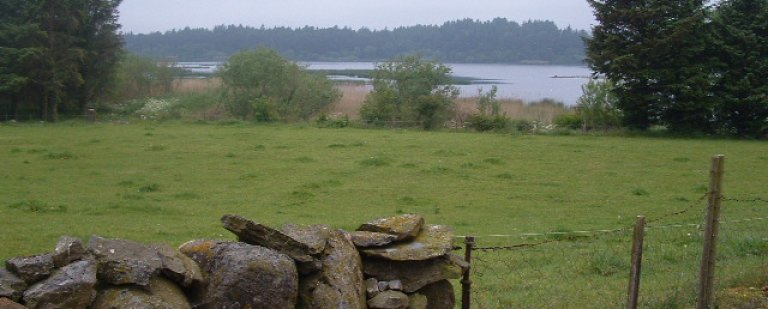
Carbon storage in soil
Carbon in soil is an important part of the global carbon cycle. The total amount of carbon just one meter below the soil surface is about two times greater than in the atmosphere. Cultivation of land causes emmisions of carbon to air and water. Measures to increase storage of carbon in the soil is therefore important.

Cultivation of land causes emissions of carbon to air and water. Emissions of CO2 from soil and vegetation, in response to cultivation, is globally estimated as 1/3 of total anthropogenic emissions the last 150 years. Loss of soil carbon is furthermore a threat to the agricultural production capacity and biodiversity. With this in mind, increased soil carbon is important to reduce CO2-emissions to the atmosphere and to maintain a sustainable agriculture.
Organic carbon has many functions in the soil:
- Source of energy to soil-living organisms
- Soil structure
- Resistance against erosion
- Storage, uptake and release of nutrients
- Water retention
- Colour (which affect the albedo-effect) and soil temperature
Biochar
Biochar can be used to increase the carbon in soil and improve the soil quality. Biochar is made from a process called pyrolysis, where biomass is exposed to high temeratures under limited oxygen access. In the pyrolysis, the carbon is changed on molecular level, which means the biochar becomes very resistant against biological decomposition. Biochar that is ploughed into the soil can therefore be stored for centuries.
Shifts from grain- to grass production
These shifts will normally result in a greater supply of organic matter (especially roots). Biological activity (eg earthworms) increases in soil with grass and makes more carbon bound to mineral particles and transport to deeper soil layers, where the carbon is more protected against decomposition. Shift from grain- to grass production can increase the carbon storage down to 80 cm depth.
This shift in production may be a possible measure on land with a great potensial for carbon storage and a low crop yield. Leveled land in Eastern Norway and Trøndelag is often exposed to erosion and contains less carbon. We therefore expect positive effects of shifts towards grass production in these areas.
Nevertheless, if the grass is used as feed for livestock, the climate effect of the carbon storage may be replaced by increased emissions of methane from livestock production. The shift from grain- to grass production is therefore only recommended on land with low soil carbon content and a low crop yield, or on land exposed to erosion in vulnerable watercourses.
Shifts in tillage practice
Intensive tillage causes faster decomposition of organic matter and increased risk of erosion. By that, intensive tillage is an important cause for reduced soil carbon. Shifts in tillage regimes, the use of cover crops, return of straw to the soil, crop rotation with grass and the use of organic fertilizer can contribute to stabilization or increase of the soil carbon content.
Alternative tillage with autumn harrowing, spring plowing or no tillage have been practiced in more than 20 years as a measure against erosion. Alternative tillage can also stabilize the carbon content in the soil.
No tillage is assumed to be the measure with the greatest effect against soil loss in grain production areas. On the other hand, this method requires costly investments and can result in reduced crop because of late drying of the field in spring. Both spring plowing and no tillage can cause weed problems and fungal diseases.
Straw as a source of bioenergy or increased soil quality?
To plow straw into the soil can contribute to increased levels of carbon i agricultural soil. This use of straw is generally only recommended if the soil carbon content is less than 2 %, if it is necessary to stabilize or increase the carbon content, or at areas especially prone to erosion.
In other cases, it is recommended to utilize the straw for bioenergy. A straw yield of 400 kg/da, with 85 % dry matter, can replace 113 kg heating oil with approx. 100 kg carbon and approx. 360 kg CO2. This use of straw might contribute to a reduction in the CO2-emissions which is much greater than the effect of soil carbon storage with the same amount of straw. Thus, if the carbon content in the soil is more than 2-3 %, the straw will be better utilized as bioenergy, in a climate perspective.
The report "Muligheter og utfordringer for økt karbonbinding i jordbruksjord" describes different topics and measures to increase the carbon storage in soil.
Publications
Authors
Daniel Rasse Inghild Økland Teresa Gómez de la Bárcena Hugh Riley Vegard Martinsen Ievina Sturite Erik J. Joner Adam O'Toole Samson Øpstad Thomas Cottis Alice BudaiAbstract
En økning i karbonlagring i landbruksjord er angitt som et viktig klimatiltak både internasjonalt og i Norge. Tiltaket er godt begrunnet: Jorden inneholder to til tre ganger så mye karbon som atmosfæren, noe som innebærer at relative små endringer i innhold av karbon i jord kan ha betydelige effekter på CO2-innholdet i atmosfæren og det globale klimaet. Det er godt dokumentert at intensive jordbruksmetoder har ført til en reduksjon i jordkarbon og derfor ønskes det en reversering av denne trenden (dvs. økt karbonbinding i jord), som tiltak både for klima og matproduksjon. I denne rapporten er det gjort vurderinger av hvordan dette kan gjøres i Norge og hvilken klimaeffekt som kan oppnås...
Abstract
Fangvekster sås sammen med korn eller etter tidligkulturer for å ta opp overskudd av næringsstoffer og redusere erosjon. Fangvekster øker karboninnholdet i jorda og reduserer ugrasmengden. Fangvekster har lenge vært anerkjent som et vannmiljøtiltak, og studier tyder på at det også er et aktuelt tiltak for å redusere klimagassutslippene fra jordbruket.
Abstract
Denne rapporten gir en oversikt over fangvekster og deres effekter på avling, mineralsk nitrogen ijord, karbonbinding, utslipp til vann og luft, jordstruktur, biodiversitet og ugras. Det er fortrinnsvis brukt studier fra Norge og Norden for å øke kunnskapen om fangvekster....
